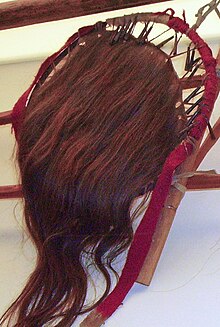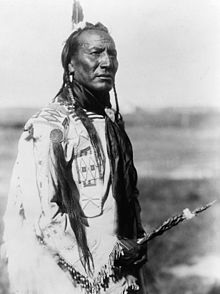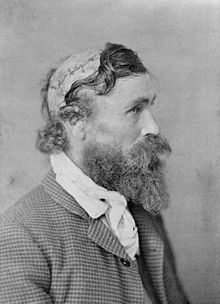Scalp

Under scalping is meant the removal of the scalp (scalp), normally together with the hair of the head , from the skull . A scalp made by intentional use of force against humans can be used as a trophy ; this method is often associated with the border conflicts in North America , where it was practiced by Indians and border settlers of European descent.
Originally, however, scalps were considered fertility symbols by soil-building peoples (worldwide), which in North America were usually mounted on long poles. Therefore, they were often used as religious ritual objects in order to positively influence the profitability of the fields - or in some cases also of women. With the Indians, scalprituals used to play an important role in cult , especially in the cultural areas of the southwest , northeast and southeast, which are characterized by agriculture .
In the South American cultural area of Chaco , at the time of the wars against the Europeans, the local equestrian tribes also scalped. As with many North American peoples, the number of scalps increased the prestige of the warrior and this was celebrated with the scalp dance.
Even in the event of an accident, scalping can occur if, for example, your hair gets into a running machine. This case could be described as a special form of décollement .
history
Antiquity

Such a practice is already described in the biblical 2nd book of the Maccabees :
Scalping was also used by the ancient Scythians in Eurasia . The Greek historian Herodotus wrote in 440 BC About the Scythians ( Historien , Book IV, 64):
“The Scythian soldiers scrape the meat from the scalp and soften it by rubbing it between their hands and then use it as a mouth cloth. The Scythian is proud of these scalps and hangs them on his reins; the more such mouth cloths a man can show, the better he is regarded. Many make camouflage coats by sewing several of these scalps together. "
Several skulls with cut marks on the temporal bones, which indicate scalping of the victims, come from a well in the Roman Villa Rustica von Burgweinting ( Regensburg ) from the 3rd century.
North America
Aborigines and settlers
According to historian James Axtell, there is no evidence that early European explorers and settlers in America knew the practices of the Scythians or that they taught the Indians to scalp. Axtell goes on to say that there is clear evidence that scalping was practiced in America long before the Europeans arrived, particularly in North America. The theory that the Indians adopted scalping from the Europeans emerged in the 1960s and is still supported by some writers and activists, but is rejected by most scholars.
As one of the first Europeans on the American continent, Bernal Díaz del Castillo describes in his book Historia verdadera de la conquista de la Nueva España that the Aztecs knew and practiced the technique of scalping. Bernal Díaz del Castillo was a soldier from 1519 and eyewitness to the conquest of the Aztec empire under Hernán Cortés .
It is believed that contact with the Europeans led to the spread of the practice of scalping among the Indians, as some American governments of European descent encouraged their Indian allies to do so in times of war. For example, during was American Revolutionary War , the British Governor Lieutenant of Canada , Henry Hamilton , among American patriots known as "hair buying General" because it was believed he encourage his Indian allies to and pay them for it to scalp American settlers. When Hamilton was captured by Americans during the war, he was treated like a war criminal rather than a prisoner of war because of it . What is certain is that Indians and American border settlers often scalped their victims during this time.
Scalp bonuses
Some governments of the English colonies in North America also sometimes suspended scalp premiums to encourage the killing of Indians. The scalps should serve as evidence of the death of an Indian. Examples:
- Massachusetts introduced a premium of £ 100 for every male Indian scalp in 1700, four times the average annual earnings at the time.
- In 1706 the governor of Pennsylvania offered 130 pesos for the scalp of every male Indian over twelve years of age and 50 pesos for every female scalp.
- In the French and Indian War, Pennsylvania offered a scalp premium for Shingas , the leader of Lenni Lenape .
Because it was impossible for those who paid the bonus to determine the gender and sometimes age, killing peaceful Indians - including women and children - became a way of making money.
The Spaniards and Mexicans in northern Mexico and what is now the American Southwest also used scalp premiums in the fight against various warlike tribes who plundered their settlements. The scalp laws of the Mexican states Chihuahua, Sonora and Durango became famous, which paid premiums for scalps of the Apaches from the 1830s until their prostration in the 1890s :
- 100 (later 200) Pesos for scalps of warriors aged 14 and over
- 50 (later 100) pesos for scalps of women
- 25 (later 50) pesos for scalps of children
At the height of the scalp boom in northern Mexico, the authorities in Chihuahua alone paid the Comanche several thousand pesos for Apache scalps or apache ears that had been cut off.
In addition to the Comanche, other traditional Indian enemies of the Apaches were scalp hunting in the Apacheria , such as the Tohono O'Odham , Akimel O'Odham , Opata and later the immigrant Kickapoo or Seminoles . American scalp hunters like James Kirker and John Glanton were also active in the Apacheria, but raided peace-loving tribes often enough to get the rewards, as this was associated with a much lower risk. All in all, the rewards that were offered on Apache scalps did not bring anything militarily - they just achieved the opposite. Because when the Apaches noticed the cruel trade, they attacked the border settlements all the more brutally and abducted cattle and people by the thousands.
Other meanings
Scalping is also used in English-speaking countries as a slang term for buying tickets to public events such as a music concert, performance, and sporting event and then reselling them with the intention of making a profit . The reseller of the cards is known as a "scalper". In British English , such a person is called a “ticket tout”.
The term scalping is used with a similar meaning for business conduct in securities trading.
See also
Web links
- British scalp Proclamation of 1756 (English)
- James Axtell: Scalps and Scalping from the Encyclopedia of North American Indians (English)
- Answer to myths about American Indian science (Believes that scalping may have been introduced to the American Indians by Europeans)
literature
- Simon Harrison: Dark Trophies. Hunting and the Enemy Body in Modern War. Berghahn Books, New York and Oxford 2012. ISBN 978-0-85745-498-0
Individual evidence
- ↑ Christian F. Feest : Animated Worlds - The religions of the Indians of North America. In: Small Library of Religions , Vol. 9, Herder, Freiburg / Basel / Vienna 1998, ISBN 3-451-23849-7 . Pp. 172-173.
- ↑ Wolfgang Lindig et al. Mark Münzel (Ed.): The Indians. Volume 2: Mark Münzel: Central and South America , 3rd revised and expanded edition of the 1st edition from 1978, dtv, Munich 1985, ISBN 3-423-04435-7 . P. 145.
- ↑ Bernal Díaz del Castillo: True History of the Conquest of Mexico. 1988, p. 407


